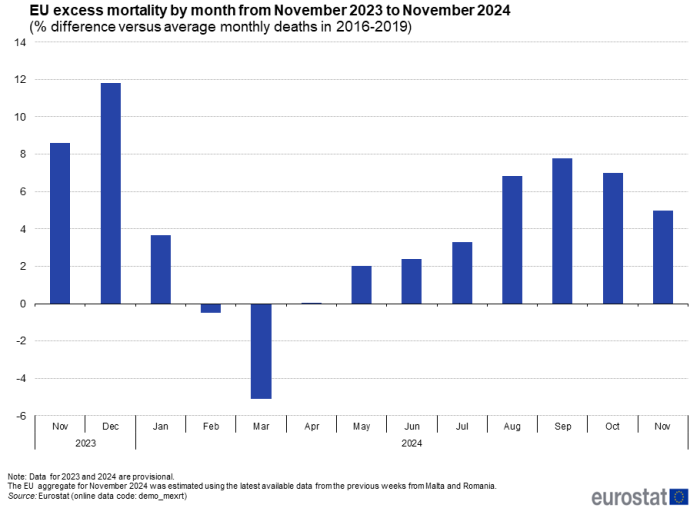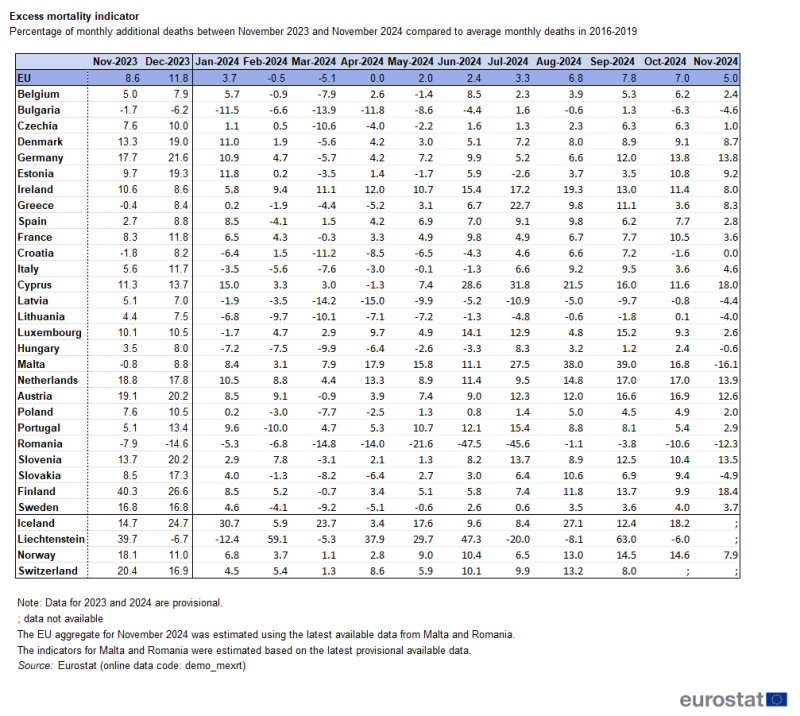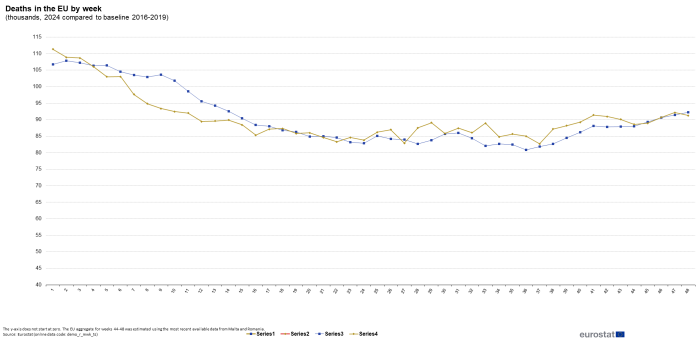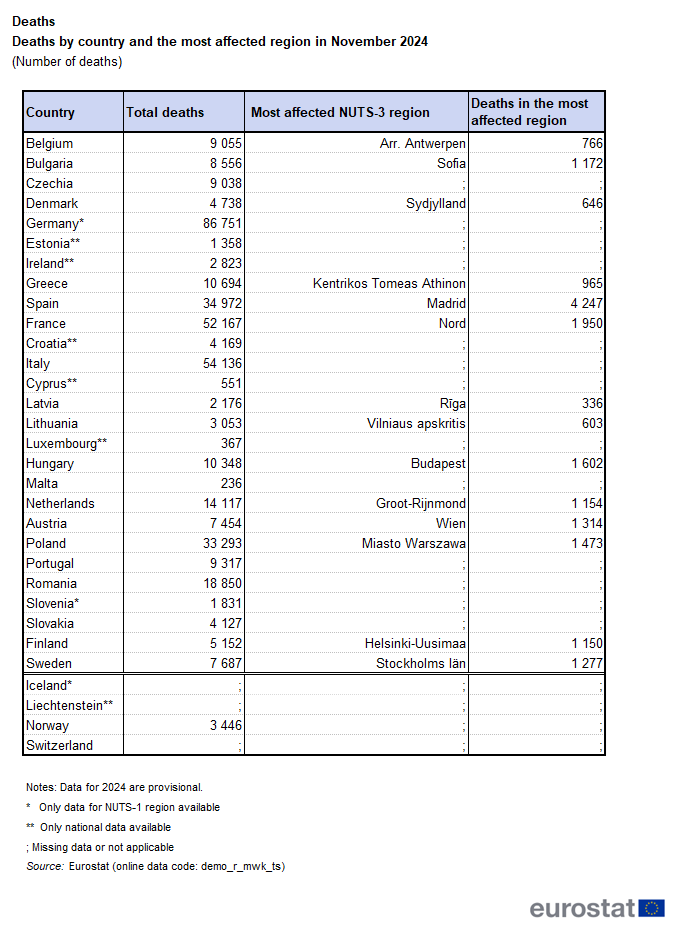Data extracted on 14 January 2025
Planned article update: 17 February 2025
Highlights
In November 2024, excess mortality decreased in the EU. The indicator decreased to 5.0% above the baseline compared with October 2024 (7.0%).
In November 2024, excess mortality continued to vary across the EU. The excess mortality rate was positive in 20 EU countries and negative in 7 of the EU countries.
In November 2024, the highest excess mortality rates were in Finland (18.4%), Cyprus (18.0%) and the Netherlands (13.9%).
This article provides an overview of the development of excess mortality in the EU in November 2024. The data covered in this analysis include all deaths that have occurred since November 2023.
In this article, excess mortality refers to the number of deaths from all causes measured during a defined period, above that which was observed in the baseline period. The baseline consists of the average number of deaths that occurred in each month during the period 2016-2019. The higher the value, the higher the number of additional deaths compared with the baseline. A negative indicator shows that fewer deaths occurred in a particular month compared with the baseline period.
This indicator, which is part of the European Statistical Monitor, provides a comprehensive comparison of additional deaths among the European countries. It provides a general measure of mortality because it includes all deaths regardless of their cause. For more information on the method to calculate the indicator, see below under Data sources.
Key findings
In November 2024, excess mortality in the EU decreased to 5.0% above the baseline, down from 7.0% in October 2024. Approximately 9 700 additional deaths were recorded, 22 000 less than in November 2023.
However, substantial variations persisted across Member States and weeks. Seven EU countries (Malta, Romania, Slovakia, Bulgaria, Latvia, Lithuania and Hungary) recorded negative excess mortality rates compared with 20 EU countries with positive rates. The highest rates were observed in Finland (18.4%), Cyprus (18.0%), and the Netherlands (13.9%).
The highest weekly rates were recorded during the second week of November, with Cyprus (30.8%), Estonia (17.6%), and the Netherlands (12.7%) reporting the highest excess mortality rates.
Recent data on excess mortality in the EU
In November 2024, excess mortality in the EU decreased to 5.0% above the baseline. By contrast, the indicator was 7.0% in October 2024 (Figure 1).

(% difference versus average monthly deaths in 2016-2019)
Source: Eurostat (demo_mexrt)
In November 2024, excess mortality continued to vary across the EU (Figure 2). The excess mortality rate was negative in 7 EU countries: the lowest rates were recorded in Malta (-16.1%), Romania (-12.3%), Slovakia (-4.9%), Bulgaria (-4.6%), Latvia (-4.4%), Lithuania (-4.0%) and Hungary (-0.6%). On the other hand, 20 EU countries registered excess deaths: the highest rates were observed in Finland (18.4%), Cyprus (18.0%), the Netherlands (13.9%), Germany (13.8%) and Slovenia (13.5%). For comparison, as presented in Table 1, in October 2024, 24 EU countries recorded excess deaths, with the highest rates observed in the Netherlands (17.0%), Austria (16.9%), Malta (16.8%), Germany (13.8%) and Cyprus (11.6%).

(% difference versus average monthly deaths in 2016-2019)
Source: Eurostat (demo_mexrt)

(Percentage of monthly additional deaths in 2023-2024 compared with average monthly deaths in 2016-2019)
Source: Eurostat (demo_mexrt)
Recent data on weekly deaths in the EU
According to the weekly death statistics, during November 2024, approximately 9 700 additional deaths were recorded compared with the average number of deaths for the same period in 2016-2019 (baseline). Compared with the previous year, there were 22 000 fewer deaths than in November 2023, when 32 000 additional deaths were recorded in the EU.
Looking at the different weeks of the month, the highest number of additional deaths was recorded in the fourth week of November 2024 (4 200).

(thousands, 2023-2024 compared with baseline 2016-2019)
Source: Eurostat (demo_r_mwk_ts)
Recent developments in the EU countries
Table 1 above shows the respective excess mortality indicator while Table 2 below shows the number of deaths in EU countries for the month of November 2024, as well as, where data are available, the most affected regions of the countries.
- During the first week of November 2024 (week 44), Malta recorded the highest excess mortality rate (20.9%). Austria and Germany followed with rates of 12.9% and 12.4%, respectively.
- In the second week of November 2024 (week 45), Cyprus had the highest excess mortality rates among the EU countries with 30.8%, followed by Estonia with 17.6% and the Netherlands with 12.7%.
- During the third week of November 2024 (week 46), Denmark (16.7%), Germany (14.2%) and Finland (14.1%) recorded the highest excess mortality rates.
- In the fourth week of November 2024 (week 47), Estonia registered the highest excess mortality rate 20.3%, followed by Finland with 20.2% and Germany with 15.6%.
- During the fifth week of November 2024 (week 48), Ireland (17.0%), Luxembourg (16.1%) and Slovenia (14.3%) recorded the highest excess mortality rates.

(Number of deaths)
Source: Eurostat (demo_r_mwk_ts)
In the tool below, you may select the country you would like to analyse.
Further releases
Data for the most recent months are provisional and subject to revision. Starting from the data reference period of January 2025, this article and the related indicator will be updated quarterly, with Q1 2025 scheduled for publication by mid-June 2025.
For additional information on the COVID-19 pandemic see Deaths during the COVID-19 pandemic.
Source data for tables and figures
Data sources
The excess mortality indicator takes the number of deaths from any cause in a given period and compares it with a historical baseline from previous years in a period that was not affected by the COVID-19 pandemic. In this case, the baseline consists of the average number of deaths that occurred in each month during the period 2016-2019. The European Union (EU) average baseline for 2016-2019 was not adjusted for age-specific mortality rates or increasing life expectancy. The indicator is expressed as the percentage of additional deaths compared with the baseline period (2016-2019). A negative percentage indicates that no additional deaths occurred in a particular month compared with the baseline period. The excess mortality indicator, covering EU and EFTA countries, is based on weekly death data transmitted to Eurostat by EU countries on a voluntary basis. Data are classified by sex, 5-year age groups and NUTS regions, and are continuously updated with more recent weeks of mortality statistics. These weekly data are then attributed pro-rata to months to compute the excess mortality indicator. For the purpose of the excess mortality indicator, the death figures for the latest weeks available in a Member State are corrected for incompleteness. Data remain provisional and subject to revision with the next releases.
The excess mortality indicator is based on a data collection for which National Statistical Institutes from the EU and the European Free Trade Association (EFTA) have transmitted weekly deaths data to Eurostat on a voluntary basis since April 2020. The weekly deaths dataset that Eurostat publishes regularly is used to compute the monthly excess mortality indicator by mapping the deaths of each week to a full month.
Thirty-one countries provide weekly mortality data: Belgium, Bulgaria, Czechia, Denmark, Germany, Estonia, Ireland, Greece, Spain, France, Croatia, Italy, Cyprus, Latvia, Lithuania, Luxembourg, Hungary, Malta, the Netherlands, Austria, Poland, Portugal, Romania, Slovenia, Slovakia, Finland, Sweden, Iceland, Liechtenstein, Norway and Switzerland. Data received from candidate and neighbouring countries are not present in this article.
The EU aggregate for November 2024 was estimated using the most recent available data for Malta and Romania. The indicators for Malta and Romania were estimated from the latest available provisional data.
Data for several countries were recalculated from 2021 onwards by applying the new coefficients of data completeness transmitted by the National Statistical Institutes in May 2023. For more information about Methodology, please consult Excess Mortality Metadata [1].
The excess mortality indicator does not distinguish between the causes of death and did not differentiate between sex and age class. For more information on causes of death statistics, please see Causes of death - monthly statistics and Causes of death statistics. During the COVID-19 pandemic, excess death statistics revealed the mortality burden potentially linked to the pandemic, encompassing not only direct virus-related deaths, but also indirect deaths. This measure included undiagnosed and unreported COVID-19 deaths as well as deaths from other causes influenced by the overall crisis. It also accounted for the reduction in deaths from other causes, such as accidents that did not occur due to restrictions on commuting or travel during lockdown periods. In the post-pandemic period, the indicator captures the effects of heat waves during summer and influenza during winter.
Context
The COVID-19 pandemic has triggered tremendous interest in statistics. Hence, in April 2020, in cooperation with the National Statistical Institutes of the European Statistical System, Eurostat set up a special data collection on weekly deaths, to support the policy and research efforts related to the pandemic. The National Statistical Institutes regularly and voluntarily transmit data to Eurostat on weekly deaths up to the latest available week. 'Excess mortality' has been identified as the most useful indicator for assessing additional deaths, complementing the other indicators contained in the European Statistical Monitor. To capture the dynamics of mortality changes in a stable way, the excess mortality indicator is calculated for each month, no later than 45 days after the end of the reference period (depending on data available to Eurostat from the National Statistical Institutes). Eurostat started to publish the excess mortality indicator in relation to the COVID-19 public health emergency announced by the World Health Organisation. While the global COVID-19 crisis is over, the indicator remains relevant and is available to capture possible future factors affecting mortality in the EU.
Explore further
Other articles
Database
- Mortality (DEMO_MEXRT), see:
- Excess mortality - monthly data (demo_mexrt)
- Mortality (demomwk), see:
- Weekly deaths - special data collection (demomwk)
Thematic section
Methodology
- Excess mortality (ESMS metadata file — demo_mexrt)
Visualisation
- Data Browser (Excess mortality line chart) - select geopolitical entity and time
- Data Browser (Excess mortality bar chart) - select time
